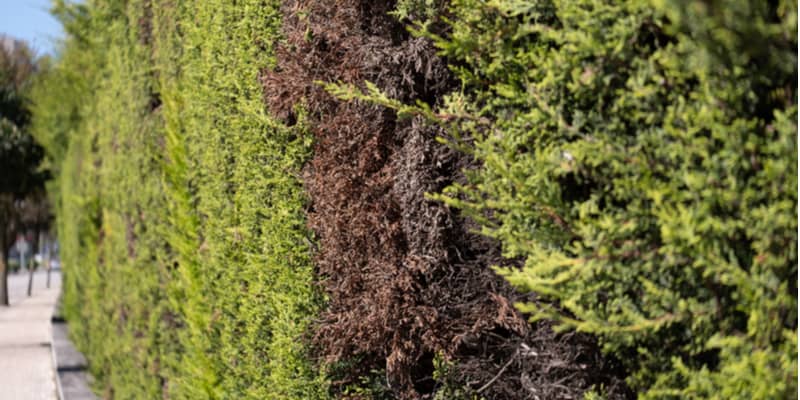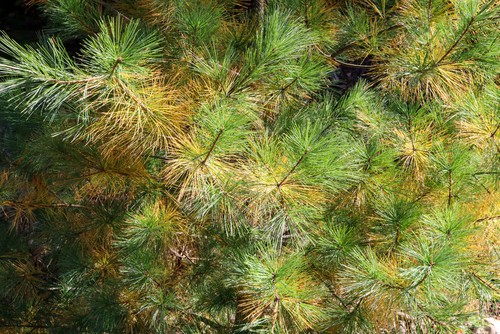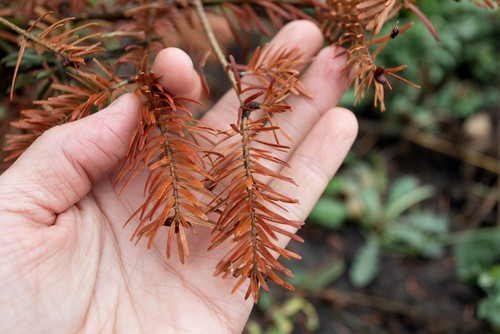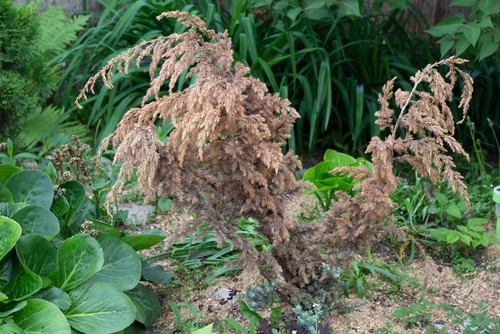
Why Are My Conifers Turning Brown? What you need to know
Our site is reader supported, this means we may earn a small commission from Amazon and other affiliates when you buy through links on our site.
If you enjoy the evergreen aesthetic that conifers offer, you might be shocked to notice wide-scale discolouration. You may wonder; why are my conifers turning brown? There is cause to be concerned because several reasons can result in conifer leaves turning brown.
However, hope is not lost because you can remedy the problem and nurse the tree back to health. Below are some common causes of leaf discolouration in conifers and some remedies you can undertake.
Pruning conifers at the wrong time of year or to hard can caurse signifancy browing of conifers
There are over 600 species of conifers and they vary in size from 30cm to over 3m. Like other plants, a little trimming is excellent in providing room for new growth; nonetheless, too much trimming can be detrimental especially at the wrong time of year. One needs to observe the time and the intensity of the trimming. I recommend trimming conifers lightly about two or three times a year specifically around April-august. With most conifers, especially Leylandii, if you prune them back significantly, for example right back to brown wood, they will not produce new growth on the old wood. With this in mind never trim back past the green foliage.
You can learn more here about how to cut the top of conifers the right way
After light trimming, ensure to feed the conifers during winter to provide nutrients and mulch to retain moisture. This helps the trees recover from the trimming particularly if you tie in new shoots in bare areas.
Look out for diseases such as needle bright needle cast and Pestalotiopsis dieback
All plants are susceptible to diseases, some are minor, and some can be devastating to them. Conifers are susceptible to diseases like needle bright and other fungal infections such as Pestalotiopsis dieback. The diseases affect the conifer causing brown spots or blisters that are treatable but preventative measures are always best. Not having conifers to compact and improving airflow and help prevent these diseases. You can also try treating with a fungicide
Needle cast disease
Identifiable by needles with yellow spots that eventually turn brown, needle cast is a disease that if left untreated causes excess shedding of conifer leaves and eventually death of the tree. Another symptom used in recognizing needle cast is tiny fruiting bodies on the needles’ surface. These tiny black bumps are spore-producing systems that spread the disease to the rest of the conifer.
If you think you have needle cast, remove the diseased needles to prevent the whole tree from infection.
Needle blight disease
Reddish-brown needle tips that eventually take over the whole needle and cause them to fall off signify needle blight. The disease spreads slowly and if left untreated it takes over the whole tree. You will notice that the disease affects the older needles before taking over the younger ones and leaving behind tiny bumps on the needles.
To prevent needle blight, as previously mentioned, ensure the plants are well spaced and receive proper ventilation even at the base of the tree. Avoid spraying water directly on the needles to prevent fungi growth and utilise mulch for moisture control. An infected conifer would benefit from copper fungicides until the disease subsides.
Pestalotiopsis dieback
Pestalotiopsis dieback is another fungal infection signified by black fruiting bodies on the needles’ surfaces. These fruiting bodies attack old leaves at first causing brown discolouration that eventually causes the needles to fall off. This disease is common in the summer or spring when conditions are wet and warm enough to create perfect fungi reproduction grounds.
It is advised to prune the infected parts and utilise fungicides. Currently, there are no specific fungicides formulated to tackle Pestalotiopsis dieback, but there are a few brands in the market that can be of assistance such as the Provanto Fungus Fighter.
Coryneum canker
Conifers are also attacked by Coryneum canker that manifests as blisters that eventually produce a yellow discharge. The tumours start at the lower branches and then proceed to infect the tree until the apex is covered. You find that leylandii cypress and Monterey cypress are particularly susceptible to the disease and usually turn yellow or brown before dying off.
Nursing the tree back to health includes the use of fungicides and the removal of the infected branches. It is essential to consider if the conifer species you have is compatible with the local climate to avoid re-infection due to high moisture periods.
Pests such as scale insects can caurse conifers to turn brown
Although cypress aphids are a common pest that attacks conifers, other pests can harm the tree and cause discolouration like scale insects. Just like their counterparts, scale insects suck sap from the foliage leaving behind damaged needles that turn brown after a while.
You will know if cypress aphids have attacked your conifer by the presence of sooty mould. I recommend the use of a suitable insecticide to rid of the aphids and mulching together with adequate feed to help the tree recover.
Weather conditions can turn conifers brown, especially in winter
Even though conifers are evergreen, lack of water during winter can cause conifer needles to go brown. The extreme cold and insufficient water reserves affect the trees; therefore, it is advised to make sure the trees are well hydrated during autumn. Winter browning can be mitigated if the trees get enough water during dry spells because they store enough water for winter.
Root rot
Sometimes, conifers may have infected wounds that in turn cause root rot. If the roots are in an unhealthy condition, it will be difficult for the leaves to maintain a healthy appearance. If your tree is not under attack from pests, fungi, or bacteria, maybe unhealthy roots are the cause of the browning needles.
Check for other symptoms like dropping branches and peeling bark to ascertain there is a root issue. Usually conifers with root root will need replacing and if you have ever noticed or had a hedge where just one conifer has died, this is usually root rot.
You can learn more about how deep conifers root here
Salt from paths and roads
If you have trees located in areas where they are in contact with road salt, then that might be the reason for the conifer needles browning. The salt people use to break down the ice in winter can damage plants particularly in high concentrations, think a gritter spreading salt right along your hedge. This is because the roots absorb more salt than required leading to dehydration.
Propper care and planting can help prevent most porblems which cause browing
It is fairly easy to keep your conifers healthy if you trim them at the right time, space them out for proper ventilation, mulch when required, and tackle any issues before they spread. If you notice any fungi or pests, there are more than enough chemicals in the market to assist even with the recent ban on many garden chemicals.
Conifers with serious infections often require help to recover. You can do this by removing the infection by pruning, using appropriate chemicals, and providing feed and mulch for the conifers to get much-needed nutrients and help retain moisture around the roots.
Also, ensure that the soil is not too wet to prevent further root rot and ensure there is proper ventilation to balance the heat or moisture.
You can learn more about how to revive a dying conifer in my guide here


